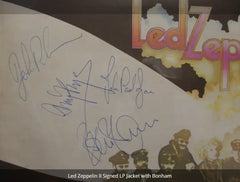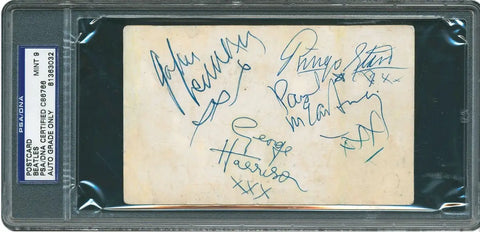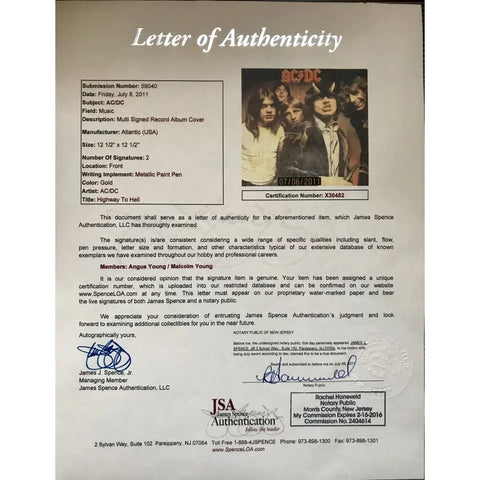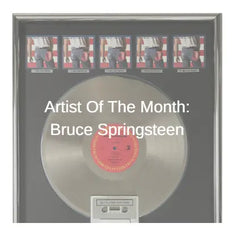So it's been a year here at MusicGoldmine.com since we wrote our first article on this topic and we're sad to see that every day, music memorabilia collectors and fans seeking real autographed items from their favorite artists are still being duped by unscrupulous sellers. (You can see that first article here--Authenticity: 5 Tips For Autograph Buyers).
Since sellers -- both on the Internet and in brick and mortar stores -- are still bilking consumers out of literally hundreds of thousands of dollars a year for their fake wares, we thought we'd provide a few more tips to help consumers detect fakes. While we'd love to out some of these sellers by naming them, we won't because we don't want to spend the next year defending our claims.
That said, we can tell you that there is no retail space that is free from these rip off sellers. They are present on websites, auction sites, and even right there in major shopping malls. They will vigorously defend their items as real, claiming that "it's all a matter of one authenticator's opinion versus another," or "our authenticators are the just as valid as their authenticators" all the while knowing that those they are using to certify their items as real are not actual authenticators at all.
So since we can't name names, instead we'll just provide some more tips to help buyers find real signed items. So here they are:
1. Do quantities and prices of the seller seem plausible? One U.S.-based online retailer actually has over 60 Beatles signed albums for sale as of the writing of this article. Many of those albums feature John Lennon. The site's selection also currently features no less than four Imagine albums signed by Lennon, all in the $600 range. Lennon signed items are exceedingly rare, in no small part because he was murdered in 1980. How about another famous rocker who died in 1980? No problem, they've got over 35 albums signed by Led Zeppelin's John Bonham along with the rest of the group. This same retailer has no less than 12 Jimi Hendrix signed albums, many which appear to be signed in felt pen, a rarely used writing instrument prior to Hendrix's 1970 death. In addition, the site has three copies of Nirvana's Nevermind signed by Kurt Cobain, another extremely rare item, all for just $700 each. The list goes on with the inventory including other almost impossible-to-find autographed items from such deceased figures as Jim Morrison of The Doors, Bob Marley and more. The chances of one company having so many of these rare items is exceedingly unlikely, especially at the prices they offer them at. The reality is that these very rare items do not come along often, and when they do, they sell for much, much more.
2. Multi-color Pens. Watch out for the multi-color pen scenario. This is one of the latest tricks of forgers. Items will have each autograph of a band member in a different color pen in order to make it seem more believable that "tough to find" group members signed the item in different locations at different times. In reality, most of the time it is only an indicator that the forger is trying to make you believe that to be true. Not all multi-color signed items are fake, but it is one of several red flags that tell you to take a closer look.
3. Study autographs yourself. In the legitimate authentication industry,  known examples of authentic autographs are used to compare to autographs being assessed. These are called exemplars. The idea is to gather together a file of autographs of the artist you have interest in that are known to be genuine. This allows you to compare an item you are looking at to a known autograph of the person. One way to do that is use images of items for which you see reliable authentication for online. (What is "reliable authentication?" Read our first article here for guidance on that). One example is well-known authenticator PSA/DNA, who have on their website genuine examples of autographs for some major figures for which many forgeries exist. One example pictured here--an actual signed Led Zeppelin album (image courtesy PSA/DNA). After a while, you'll be able to see problems with autographs. Maybe it's clear that the signer's pen pressure is different. Maybe the slant, loops or ways that letters are formed are different from the exemplar. No one can become and expert at this without significant study and an excellent eye but using your own ability can help you spot the most obvious of fakes. Another consideration that involves study of exemplars is how a person's autograph has evolved over time. Most people's autographs evolve over time, which enables an astute observer to help date the autograph and this can consequently, when combined with other factors such as age of the object signed and so forth, help determine authenticity. While autograph evolution is usually more subtle, here's a dramatic example:
known examples of authentic autographs are used to compare to autographs being assessed. These are called exemplars. The idea is to gather together a file of autographs of the artist you have interest in that are known to be genuine. This allows you to compare an item you are looking at to a known autograph of the person. One way to do that is use images of items for which you see reliable authentication for online. (What is "reliable authentication?" Read our first article here for guidance on that). One example is well-known authenticator PSA/DNA, who have on their website genuine examples of autographs for some major figures for which many forgeries exist. One example pictured here--an actual signed Led Zeppelin album (image courtesy PSA/DNA). After a while, you'll be able to see problems with autographs. Maybe it's clear that the signer's pen pressure is different. Maybe the slant, loops or ways that letters are formed are different from the exemplar. No one can become and expert at this without significant study and an excellent eye but using your own ability can help you spot the most obvious of fakes. Another consideration that involves study of exemplars is how a person's autograph has evolved over time. Most people's autographs evolve over time, which enables an astute observer to help date the autograph and this can consequently, when combined with other factors such as age of the object signed and so forth, help determine authenticity. While autograph evolution is usually more subtle, here's a dramatic example:
According to Perry D. Cox, a noted Beatles autograph and memorabilia expert, Ringo Starr's autograph from 1992-99 appeared like this, with Ringo utilizing the "star" symbol only during that period (MusicGoldmine photo of Perry D. Cox authenticated item):

Compare that to this early Starr signature, estimated to be from the mid-60s (image courtesy PSA/DNA):

One can use this information to assess, for example, whether the lower post card and the upper photo are correct for the time periods in which they were signed. Sometimes it is a known fact that a person stopped signing autographs altogether at a certain point. For example, that is the case with Ringo, who stopped signing autographs altogether in 2008 according to Cox. This is another factor one must always consider when assessing an autograph and the age of the object signed.
4. Wear and Tear. What do your 40-year-old albums look like? It's simply amazing to see the stellar condition of the signed albums from some sellers. No wear on the corners, no bends. It's almost as if they were purchased just recently. Oh wait, they were! Then they were supplied to an autograph forger, who has spent a lot of time practicing and perfecting certain famous music figures' autographs... In the real world, genuine autographs more often appear on original issue albums that have some wear and tear, like this (MusicGoldmine photo of Roger Epperson authenticated Keith Richards autograph):
This is sometimes because the item was signed long ago, which is often true for older artists who are less accessible today, but it is also at times simply because the person getting it signed had to carry it through thick and thin -- to the backstage area at a concert or festival, to a hotel, in an airport, etc. -- to get it signed.
Having said all that, artists who were still alive today could possibly have signed a newer copy more recently. However, an autograph of an older artist who may have made themselves less available to sign in their later years (or who has stopped signing altogether) makes finding a new-appearing item that has been signed another red flag that should prompt further examination.
Also, it is common for older real autographs to have faded somewhat. If John Bonham and John Lennon died in 1980, each of their autographs would -- by 2020 for example -- have to have survived for at least 40 years on whatever item was signed and with whatever pen it was signed with. Inspect the item that to see if it seems like the autograph on it matches the age it would need to be. If it doesn't, give it a pass.
Note also that neither the existence of wear, the fact that an item is genuinely old nor fading ink are, on their own, indicators of autograph authenticity either. A recently observed trick that helps sell a forger's story is the use of a genuinely old and original event ticket, program, invitation, instrument or the like that a forger then signs. A genuine article from the correct era can fool a buyer into thinking a genuine autograph is also present. Buyers should think again. That ticket, program or 60s guitar might be cool to own since it is real, but a fake autograph on it certainly renders it worth less than a simple unsigned version of the same thing.
5. Sharpies® didn't exist in 1960. Another thing to pay attention to is what writing instrument was used. While permanent markers were first manufactured in 1964, they really weren't commonplace until the 80s. Case in point: Every real John Bonham autograph we've ever seen is in ballpoint pen, showing his distinctive, narrow pen strokes. All early Beatles autographs were in ballpoint pen. Think about the date your favorite artist left us and think about the pen that they actually had access to when signing an item. It's not a hard and fast rule that felt markers were never used for one artist or another, but common sense tells us that it was very uncommon pre-1980.
And one extra tip, which is just a repeat from our first article but so important:
6. Ask for a top tier authenticator's Certificate or Letter of Authenticity COA or LOA): Does the seller have item authentication from BAS (Beckett Authentication Services), JSA (James Spence Authentication), PSA/DNA (Professional Sports Authenticator), or REAL (Roger Epperson Authentication Ltd.)? These authenticators are all leaders in the field as recognized by top auction houses, online auction sites such as eBay, and autograph collector organizations. If they do not -- and especially if they will not let you independently seek authentication from a top company -- consider it a red flag. Are these authentication companies completely infallible? No, but they are the most reliable companies out there providing proof of autograph authenticity. There are also some good specialist authenticators out there as well, it should be noted, such as Frank Caiazzo (Beatles), Perry D. Cox (Beatles and Beach Boys) and Tracks Ltd. UK (Beatles and other rock). Here's an example of a Letter of Authenticity from JSA:

For our current selection of authenticated autographed items, go here.
For more content like this, updates on our latest arrivals plus a discount code, subscribe to our MusicGoldmine bi-weekly newsletter here.




Editor’s Note: Thanks for the comment Martin, another excellent point for Zeppelin collectors to keep in mind.
Another comment to add to false Led Zeppelin signings
It is very very rare that all members of the band signed together ,they were always bickering or not talking to each other .So most items that had so members signature on the same item are very very rare .
Watch out !